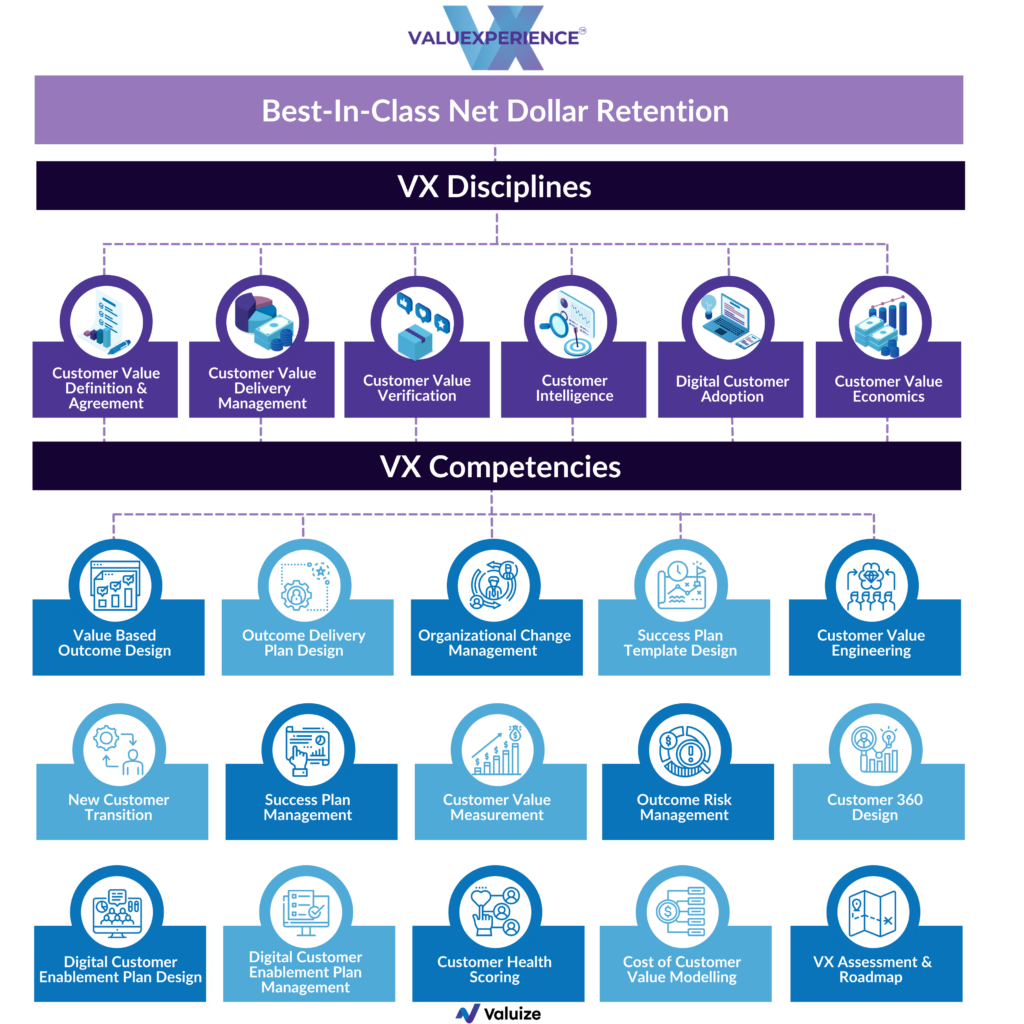Is Your Net Dollar Retention Engine Operating At Peak Efficiency?
The process of achieving best-in-class Net Dollar Retention (NDR) is akin to running a well-oiled machine. All of the different cogs and systems that power NDR – customer acquisition, product adoption and revenue retention and expansion – must run smoothly and efficiently in order to keep the engine going. Because all of these cogs are dependent on each other, this system must be integrated and interconnected to drive best-in-class Net Dollar Retention. While leaders realize the necessity of this consolidated system, only an elite handful of companies have achieved this nirvana. Are all of your cross-functional teams operating as a single function in support of driving optimal value for your customers and market-leading NDR for your business?
Remnants of the past license-based model with siloed and sometimes conflicting functions, varying goals and disjointed systems, are still affecting operations today, especially in enterprise-sized technology companies. The existence of these disjointed processes pose a real threat to your ability to scale your NDR motion and can prevent this powerful engine from operating at peak efficiency.
In this article, we outline how you can address the most pervasive problems that are preventing you from running a smooth NDR engine and introduce a new proven value realization framework you can use to unite your organization around a connected customer lifecycle that drives best-in-class Net Dollar Retention.
The Problems Of A Siloed Customer Lifecycle
A customer-vendor relationship is a multi-phase relationship, beginning with acquisition through to adoption, retention and expansion. If you look at this customer lifecycle through the lens of your organizational ecosystem, each phase involves multiple functions and teams who are supporting and shepherding the customer through this customer journey. At the same time, you’ve also got core operating functions that support the entire business, like Product, Finance, IT, and Engineering. With this multifaceted yet interconnected ecosystem, the biggest challenge that organizations face is the sheer volume of different folks in the room and the fact that each group has their own goals, mission, systems, and data.
For example, perhaps the mission of your Professional Services function is to implement and launch customers on time and within budget, and achieve a certain margin. To propel this forward, the Professional Services function might utilize a strategy of specific activities and workflows, insights and data that they personally care about, and technology that is specific to them. But, then you look at the Sales organization who also have a mission: achieve net new revenue booking targets. This function is also going to achieve this through their own strategy, technology, and data to drive the organization forward. By focusing on a separate strategy, technology, and data, these two organizations alone may actually be at odds with one another, creating self-perpetuating siloes that extend to your entire organization and create barriers between all of the different functions that influence your customer lifecycle.
This example extends across your entire organization. These different missions are disconnecting your teams from one another, preventing unification and collaboration that’s required to successfully and smoothly move your customer through the journey from acquisition to adoption, retention and expansion.
How To Make NDR Your North Star
While you may not be able to change the dynamics and fundamental nature of each of these functions due to cultural, political and organizational strategic and economic legacies, you can unite them with a common North Star objective: Net Dollar Retention. That is not to say that completing implementations on time and within budget, or achieving a net new bookings target this quarter is wrong. They’re absolutely right and important in terms of how they contribute towards value in the business. However, if we look at recurring revenue technology companies specifically, your valuations, and ultimately your sustainable growth and profitability, are driven by your ability to have an NDR engine and a customer lifecycle that’s integrated to maximize NDR.
To achieve this, shift away from a functional architecture concept and place Net Dollar Retention in the center so that it unites all of these functions through a value realization framework. With NDR as the central mission of the business, each function can more closely align their strategies to work in tandem with each other to create measurable value for customers. Your measurable customer value realization is the key: product usage and engagement with your company must equate to measurable value realization for your customers. That equation is how you will drive unparalleled Net Dollar Retention. If you’re in the early stages of building that equation, we recommend following these steps to unite your Pre- and Post-Sales around value selling and success to create a powerful value realization framework.
Unifying your entire organization’s North Star mission around measurable customer value across their lifecycle, and not just the functional responsibility of Customer Success, is the foundation of a cutting-edge customer lifecycle that drives best-in-class Net Dollar Retention.
Introducing ValueXperience, The Proven Value Realization Framework To Drive Best-In-Class NDR
In order to tackle the challenges outlined above to unite your customer lifecycle in pursuit of market-leading NDR, Valuize has created a new value realization framework: ValueXperience. Based on combined decades of experience working as operators and consultants with world-leading B2B technology enterprises, the goal of this value realization framework is to help leaders get clear on:
- How to drive the mission of creating measurable value for customers through the use of your products
- The disciplines you need to master as an organization to drive best-in-class Net Dollar Retention
ValueXperience enables a functionally agnostic approach to your customer lifecycle and creates a closely integrated organization through 6 key disciplines and 15 approachable competencies. Each VX Discipline consists of a specific set of VX Competencies that, once achieved, will result in your organization’s effective, efficient and scalable mastery of the discipline. The VX Competencies enable your organization to take a ‘bite-size’ approach to developing the knowledge, skills and behaviors required to evolve and transform your entire customer lifecycle in pursuit of best-in-class NDR.

At the heart of the ValueXperience framework is the following key principle:
In order for a vendor to retain and expand a customer, the vendor must be able to verify that measurable value has been realized by the customer through their use of the vendor’s product.
To learn how you can unite your customer lifecycle and enable best-in-class Net Dollar retention in your organization, and assess where you stand as a business today on your path to market-leading NDR, download our in-depth whitepaper about ValueXperience.
Join The Customer Lifecycle Revolution With A New Value Realization Framework
The Customer Success status quo is preventing you from driving sustainable market-leading Net Dollar Retention. By making customer value realization the functional responsibility of Customer Success alone, you are continuing to strengthen the silos that exist in your organization and the roadblocks along your customer journey. A united and collaborative customer lifecycle that is connected through a common North Star mission is the only way to drive best-in-class Net Dollar Retention in the modern subscription economy.
To successfully unite your cross-functional organization, you need a shared mission and a common language. In the world of recurring revenue B2B technology, that language is customer value. Discover the difference between customer value and outcomes and how to define measurable customer value to unify your organization.





